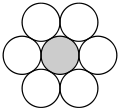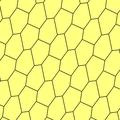Hexagonal tiling
This article includes a list of general references, but it lacks sufficient corresponding inline citations. (March 2011) |
| Hexagonal tiling | |
|---|---|
 | |
| Type | Regular tiling
|
| Vertex configuration | 6.6.6 (or 63) |
Face configuration |
V3.3.3.3.3.3 (or V36) |
| Schläfli symbol(s) | {6,3} t{3,6} |
| Wythoff symbol(s) | 3 | 6 2 2 6 | 3 3 3 3 | |
| Coxeter diagram(s) | |
| Symmetry | p6m , [6,3], (*632)
|
| Rotation symmetry | p6 , [6,3]+, (632)
|
| Dual | Triangular tiling |
| Properties | face-transitive
|
In
English mathematician John Conway called it a hextille.
The
Applications
Hexagonal tiling is the densest way to
This structure exists naturally in the form of
Chicken wire consists of a hexagonal lattice (often not regular) of wires.
-
The densest circle packing is arranged like the hexagons in this tiling
-
Chicken wire fencing
-
Acylindricalsurface
-
Hexagonal Persian tile c.1955
The hexagonal tiling appears in many crystals. In three dimensions, the
Uniform colorings
There are three distinct
| k-uniform | 1-uniform | 2-uniform | 3-uniform | ||||
|---|---|---|---|---|---|---|---|
| Symmetry | p6m, (*632) | p3m1, (*333) | p6m, (*632) | p6, (632) | |||
| Picture | 
|

|

|

|
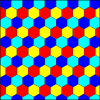
|

|

|
| Colors | 1 | 2 | 3 | 2 | 4 | 2 | 7 |
| (h,k) | (1,0) | (1,1) | (2,0) | (2,1) | |||
| Schläfli | {6,3} | t{3,6} | t{3[3]} | ||||
| Wythoff | 3 | 6 2 | 2 6 | 3 | 3 3 3 | | ||||
Coxeter
|
|||||||
| Conway | H | tΔ | cH=t6daH | wH=t6dsH | |||
The 3-color tiling is a tessellation generated by the order-3 permutohedrons.
Chamfered hexagonal tiling
A

| Hexagons (H) | Chamfered hexagons (cH) | Rhombi (daH) | ||
|---|---|---|---|---|
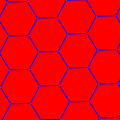
|

|

|

|

|
Related tilings
The hexagons can be dissected into sets of 6 triangles. This process leads to two
| Regular tiling | Dissection | 2-uniform tilings
|
Regular tiling | Inset | Dual Tilings | |
|---|---|---|---|---|---|---|
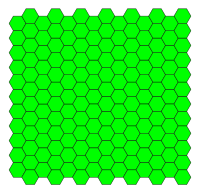 Original |
 
|
 1/3 dissected |
 2/3 dissected |
 fully dissected |

|
 E to IH to FH to H |
The hexagonal tiling can be considered an elongated rhombic tiling, where each vertex of the rhombic tiling is stretched into a new edge. This is similar to the relation of the
 Rhombic tiling |
 Hexagonal tiling |
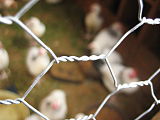 Fencing uses this relation |
It is also possible to subdivide the prototiles of certain hexagonal tilings by two, three, four or nine equal pentagons:
 Pentagonal tiling type 1 with overlays of regular hexagons (each comprising 2 pentagons). |
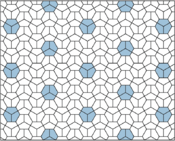 pentagonal tiling type 3 with overlays of regular hexagons (each comprising 3 pentagons). |
 Pentagonal tiling type 4 with overlays of semiregular hexagons (each comprising 4 pentagons). |
 Pentagonal tiling type 3 with overlays of two sizes of regular hexagons (comprising 3 and 9 pentagons respectively). |
Symmetry mutations
This tiling is topologically related as a part of a sequence of regular tilings with
| *n62 symmetry mutation of regular tilings: {6,n} | ||||||||
|---|---|---|---|---|---|---|---|---|
| Spherical | Euclidean | Hyperbolic tilings | ||||||
 {6,2} |
 {6,3} |
 {6,4} |
 {6,5} |
 {6,6} |
 {6,7} |
 {6,8} |
... |  {6,∞} |
This tiling is topologically related to regular polyhedra with vertex figure n3, as a part of a sequence that continues into the hyperbolic plane.
| *n32 symmetry mutation of regular tilings: {n,3} | |||||||||||
|---|---|---|---|---|---|---|---|---|---|---|---|
| Spherical | Euclidean
|
Compact hyperb. | Paraco. | Noncompact hyperbolic | |||||||

|

|

|

|

|

|

|

|

|

|

|

|
| {2,3} | {3,3} | {4,3} | {5,3} | {6,3} | {7,3} | {8,3} | {∞,3} | {12i,3} | {9i,3} | {6i,3} | {3i,3} |
It is similarly related to the uniform truncated polyhedra with vertex figure n.6.6.
| *n32 symmetry mutation of truncated tilings: n.6.6 | ||||||||||||
|---|---|---|---|---|---|---|---|---|---|---|---|---|
| Sym. *n42 [n,3] |
Spherical | Euclid. | Compact | Parac. | Noncompact hyperbolic | |||||||
| *232 [2,3] |
*332 [3,3] |
*432 [4,3] |
*532 [5,3] |
*632 [6,3] |
*732 [7,3] |
*832 [8,3]... |
*∞32 [∞,3] |
[12i,3] | [9i,3] | [6i,3] | ||
| Truncated figures |

|

|

|

|

|

|

|

|

|

|

| |
| Config. | 2.6.6 | 3.6.6 | 4.6.6 | 5.6.6 | 6.6.6 | 7.6.6 | 8.6.6 | ∞.6.6 | 12i.6.6 | 9i.6.6 | 6i.6.6 | |
| n-kis figures |

|

|

|

|

|

|

|

|
||||
Config.
|
V2.6.6 | V3.6.6 | V4.6.6 | V5.6.6 | V6.6.6
|
V7.6.6 | V8.6.6 | V∞.6.6 | V12i.6.6 | V9i.6.6 | V6i.6.6 | |
This tiling is also part of a sequence of truncated rhombic polyhedra and tilings with [n,3] Coxeter group symmetry. The cube can be seen as a rhombic hexahedron where the rhombi are squares. The truncated forms have regular n-gons at the truncated vertices, and nonregular hexagonal faces.
| Symmetry mutations of dual quasiregular tilings: V(3.n)2 | |||||||||||
|---|---|---|---|---|---|---|---|---|---|---|---|
| *n32 | Spherical | Euclidean | Hyperbolic | ||||||||
| *332 | *432 | *532 | *632 | *732 | *832... | *∞32 | |||||
| Tiling | 
|

|

|

|

|

|

| ||||
Conf.
|
V(3.3)2 | V(3.4)2 | V(3.5)2 | V(3.6)2 | V(3.7)2 | V(3.8)2 | V(3.∞)2 | ||||
Wythoff constructions from hexagonal and triangular tilings
Like the uniform polyhedra there are eight uniform tilings that can be based on the regular hexagonal tiling (or the dual triangular tiling).
Drawing the tiles colored red on the original faces, yellow at the original vertices, and blue along the original edges, there are 8 forms, 7 of which are topologically distinct. (The truncated triangular tiling is topologically identical to the hexagonal tiling.)
| Uniform hexagonal/triangular tilings | ||||||||
|---|---|---|---|---|---|---|---|---|
| Fundamental domains |
Symmetry: [6,3], (*632) | [6,3]+, (632) | ||||||
| {6,3} | t{6,3} | r{6,3} | t{3,6} | {3,6} | rr{6,3} | tr{6,3} | sr{6,3} | |

|

|

|

|

|

|

|

|

|
| Config. | 63 | 3.12.12 | (6.3)2 | 6.6.6 | 36 | 3.4.6.4 | 4.6.12 | 3.3.3.3.6 |
Monohedral convex hexagonal tilings
There are 3 types of monohedral convex hexagonal tilings.[1] They are all isohedral. Each has parametric variations within a fixed symmetry. Type 2 contains glide reflections, and is 2-isohedral keeping chiral pairs distinct.
Topologically equivalent tilings
Hexagonal tilings can be made with the identical {6,3} topology as the regular tiling (3 hexagons around every vertex). With isohedral faces, there are 13 variations. Symmetry given assumes all faces are the same color. Colors here represent the lattice positions.[2] Single-color (1-tile) lattices are parallelogon hexagons.
| pg (××) | p2 (2222) | p3 (333) | pmg (22*) | |||
|---|---|---|---|---|---|---|

|

|

|

|

|

| |
| pgg (22×) | p31m (3*3) | p2 (2222) | cmm (2*22) | p6m (*632) | ||

|

|

|

|

|

|

|
Other isohedrally-tiled topological hexagonal tilings are seen as quadrilaterals and pentagons that are not edge-to-edge, but interpreted as colinear adjacent edges:
| pmg (22*) | pgg (22×) | cmm (2*22) | p2 (2222) | |||
|---|---|---|---|---|---|---|
 Parallelogram |
 Trapezoid |
 Parallelogram |
 Rectangle |
 Parallelogram |
 Rectangle |
 Rectangle |
| p2 (2222) | pgg (22×) | p3 (333) |
|---|---|---|

|

|

|
The 2-uniform and 3-uniform tessellations have a rotational degree of freedom which distorts 2/3 of the hexagons, including a colinear case that can also be seen as a non-edge-to-edge tiling of hexagons and larger triangles.[3]
It can also be distorted into a chiral 4-colored tri-directional weaved pattern, distorting some hexagons into parallelograms. The weaved pattern with 2 colored faces has rotational 632 (p6) symmetry. A chevron pattern has pmg (22*) symmetry, which is lowered to p1 (°) with 3 or 4 colored tiles.
| Regular | Gyrated | Regular | Weaved | Chevron |
|---|---|---|---|---|
| p6m, (*632) | p6, (632) | p6m (*632) | p6 (632) | p1 (°) |

|

|

|

|

|
| p3m1, (*333) | p3, (333) | p6m (*632) | p2 (2222) | p1 (°) |

|

|

|
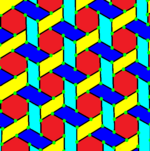
|

|
Circle packing
The hexagonal tiling can be used as a circle packing, placing equal-diameter circles at the center of every point. Every circle is in contact with 3 other circles in the packing (kissing number).[4] The gap inside each hexagon allows for one circle, creating the densest packing from the triangular tiling, with each circle in contact with a maximum of 6 circles.
Related regular complex apeirogons
There are 2
The first is made of 2-edges, three around every vertex, the second has hexagonal edges, three around every vertex. A third complex apeirogon, sharing the same vertices, is quasiregular, which alternates 2-edges and 6-edges.

|

|

|
| 2{12}3 or |
6{4}3 or |
|---|
See also
- Hexagonal lattice
- Hexagonal prismatic honeycomb
- Tilings of regular polygons
- List of uniform tilings
- List of regular polytopes
- Hexagonal tiling honeycomb
- Hex map board game design
References
- ^ Tilings and patterns, Sec. 9.3 Other Monohedral tilings by convex polygons
- ^ Tilings and patterns, from list of 107 isohedral tilings, pp. 473–481
- ^ Tilings and patterns, uniform tilings that are not edge-to-edge
- ^ Order in Space: A design source book, Keith Critchlow, pp. 74–75, pattern 2
- ^ Coxeter, Regular Complex Polytopes, pp. 111–112, p. 136.
- ISBN 0-486-61480-8p. 296, Table II: Regular honeycombs
- ISBN 0-7167-1193-1. (Chapter 2.1: Regular and uniform tilings, pp. 58–65)
- ISBN 0-486-23729-X.
- John H. Conway, Heidi Burgiel, ISBN 978-1-56881-220-5 [1]
External links
- Weisstein, Eric W. "Hexagonal Grid". MathWorld.
- Klitzing, Richard. "2D Euclidean tilings o3o6x – hexat – O3".
| Space | Family | / / | ||||
|---|---|---|---|---|---|---|
| E2 | Uniform tiling | {3[3]} | δ3 | hδ3 | qδ3 | Hexagonal |
| E3 | Uniform convex honeycomb
|
{3[4]} | δ4 | hδ4 | qδ4 | |
| E4 | Uniform 4-honeycomb
|
{3[5]} | δ5 | hδ5 | qδ5 | 24-cell honeycomb |
| E5 | Uniform 5-honeycomb
|
{3[6]} | δ6 | hδ6 | qδ6 | |
| E6 | Uniform 6-honeycomb
|
{3[7]} | δ7 | hδ7 | qδ7 | 222 |
| E7 | Uniform 7-honeycomb
|
{3[8]} | δ8 | hδ8 | qδ8 | 133 • 331 |
| E8 | Uniform 8-honeycomb
|
{3[9]} | δ9 | hδ9 | qδ9 | 152 • 251 • 521 |
| E9 | Uniform 9-honeycomb
|
{3[10]} | δ10 | hδ10 | qδ10 | |
| E10 | Uniform 10-honeycomb | {3[11]} | δ11 | hδ11 | qδ11 | |
| En-1 | Uniform (n-1)-honeycomb | {3[n]}
|
δn | hδn | qδn | 1k2 • 2k1 • k21 |

